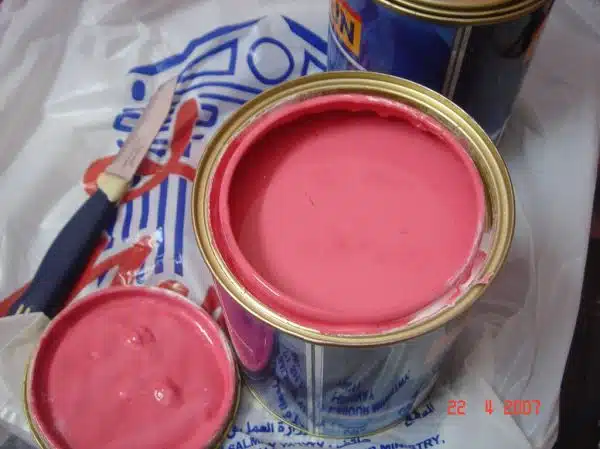Painting a room can be an overwhelming task for many homeowners, but it doesn’t have to be. As a professional house painter, I have completed countless paint jobs and have learned the best techniques to achieve a flawless finish. In this article, I will share my knowledge and experience on how to paint a room like a professional.
Firstly, it is important to properly prepare the room before beginning any painting. This includes removing furniture, covering floors with protective drop cloths, and cleaning walls of any dust or dirt. Choosing the right tools and materials such as high-quality paint, brushes, rollers, and tape is also crucial for achieving optimal results. By following these steps and utilizing proper painting techniques such as cutting in and rolling efficiently, anyone can transform their space into a professionally painted room.
Preparing Your Room For Painting
Before painting a room, it is essential to prepare the space to ensure a flawless finish. Taping techniques can be used to protect areas that do not require paint, such as baseboards, window frames or door frames. Using painter’s tape, apply it in straight lines along the edges of surfaces that you want to protect from paint spills or drips. It is important to press the tape firmly to prevent any gaps.
Wall patching is another crucial step in preparing a room for painting. Small holes or cracks can be filled using spackling paste and a putty knife. For larger holes, use a drywall patch and apply spackling paste over the area with a putty knife. Allow the spackle to dry completely before sanding it down until smooth. Properly patched walls will result in an even surface and enhance the overall appearance of the painted walls.
Once taping and wall patching are complete, it is time to start removing furniture and covering floors with protective materials like drop cloths or plastic sheeting. This will prevent paint drips from staining your flooring or damaging your furniture. Furniture should be moved away from the walls or covered with drop cloths if they cannot be moved out of the room. Covering floors with drop cloths will also make cleaning up easier after completing the painting process.
Removing Furniture And Covering Floors
As a professional house painter, I know that the first step to ensuring a successful paint job is to remove all furniture from the room. It may seem like an unnecessary hassle, but trust me, it will make the job much easier in the long run. You don’t want to risk getting paint on your valuable furniture or having to maneuver around it while you work.
Once all furniture has been removed, it’s time to protect your floors. Covering your floors with a drop cloth or plastic sheeting is crucial in preventing any accidental spills or splatters from damaging your flooring. Make sure the entire floor is covered and secured with tape so that it doesn’t shift during the painting process.
Furniture protection and floor covering are just as important as choosing the right paint color and tools. By taking these precautions, you’ll not only prevent damage to your property but also create a safe and efficient workspace for yourself. Next up, we’ll discuss how to clean your walls before starting on the actual painting process.
Cleaning Your Walls
After successfully removing all furniture from the room and covering the floors with drop cloths, it’s time to prepare your walls for painting. Before cleaning your walls, inspect them for any damages that need repair. These could include cracks, holes, or chipped paint.
To make pre-painting repairs, you will need a few supplies such as spackle, sandpaper, and a putty knife. Begin by filling any holes or cracks with spackle using a putty knife. Once dry, use sandpaper to smooth out the surface before applying another layer of spackle if needed. Repeat this process until the surface is smooth and even.
Now that your walls are repaired and ready for painting, it’s important to clean them thoroughly using appropriate cleaning supplies. Start by dusting off any loose debris with a soft-bristled brush or vacuum cleaner attachment. Then wipe down the walls with a damp cloth or sponge and mild soap solution. Rinse off the soap residue with clean water and let the walls dry completely before moving on to the next step.
Four essential items for preparing walls for painting:
- Spackle
- Sandpaper
- Putty Knife
- Mild soap solution
With these steps completed, you’re well on your way to achieving professional-looking results in your room painting project. Next up: choosing the right tools and materials for painting!
Choosing The Right Tools And Materials
As professional painters, we know that a bad workman blames his tools. However, when it comes to painting a room like a pro, choosing the right tools and materials is key. Don’t just settle for any old paintbrush or roller – invest in the best brands to ensure a high-quality finish.
When it comes to essential tools, you’ll need more than just brushes and rollers. Don’t forget about painter’s tape, drop cloths, paint trays, and stir sticks. These may seem like small details, but they play an important role in achieving a flawless finish. And for those eco-friendly options and sustainable materials enthusiasts out there, fear not – there are plenty of options available on the market today.
Not only do quality tools and materials make your job easier as a painter, but they also help ensure that your work stands the test of time. So before you start your next project, take the time to invest in the best brands and consider eco-friendly options for a truly professional result. Next up: selecting high-quality paint that will elevate your project even further.
Selecting High-Quality Paint
When selecting high-quality paint for a room, it is important to consider the finish of the paint, as this can greatly affect the overall look of the room. Evaluating the sheen levels of the paint is also important, as this will determine the amount of light reflection and the amount of durability that the paint offers. Furthermore, the color options of the paint should be carefully evaluated to ensure that it will match the desired aesthetic of the room. It is also important to determine whether the paint is washable, as this will affect how easy it is to maintain the paint job. Examining the coverage rate of the paint is also important, as this will determine how much paint is needed to cover the room. Lastly, it is important to make sure that the paint is resistant to mold and mildew, as this will help ensure that the room remains in good condition over time.
Examining Paint Finish
As a professional house painter, one of the critical steps in selecting high-quality paint is examining the paint finish. Exploring sheen options and comparing matte vs. glossy finishes can make a significant difference in achieving the desired look for any room. The finish affects the overall appearance, durability, and maintenance of the painted surface.
Matte finishes are perfect for hiding imperfections and uneven surfaces as they absorb light, providing a smooth and subtle appearance. They are ideal for bedrooms, living rooms, and dining rooms where low traffic is expected. On the other hand, glossy finishes reflect more light, making them ideal for high-traffic areas such as kitchens and bathrooms that require frequent cleaning. However, it’s important to note that they can highlight imperfections on walls.
Satin or eggshell finishes offer a balance between matte and glossy finishes. They provide a slight shine with better durability than matte but not as much as gloss paint. Satin finishes are suitable for living rooms, dining rooms, hallways, kitchens, and bathrooms where moisture levels are low to moderate. Ultimately, choosing the right paint finish comes down to personal preferences and practical considerations such as the room’s function and level of traffic.
Considering Sheen Levels
As a professional house painter, selecting high-quality paint is crucial in achieving the desired finish for any room. One of the critical factors to consider when choosing paint is sheen level, which affects the overall appearance, durability, and maintenance of painted surfaces. Choosing the right sheen level can be challenging, but understanding its impact on lighting can help achieve the desired effect.
When considering sheen levels, it’s essential to understand how lighting affects their appearance. Sheen levels range from matte to glossy and each has its pros and cons. A matte finish absorbs light, providing a smooth and subtle appearance ideal for hiding imperfections and uneven surfaces. Glossy finishes reflect more light, making them ideal for high-traffic areas that require frequent cleaning. Satin or eggshell finishes offer a balance between matte and glossy finishes.
Choosing the right sheen level depends on personal preferences and practical considerations such as the room’s function and lighting conditions. For instance, rooms with low natural light benefit from using glossier finishes as they reflect more light, while rooms with bright natural light may look better with a matte finish to reduce glare. Ultimately, understanding how lighting affects different sheen levels can help homeowners make an informed decision when choosing high-quality paint for their home.
Evaluating Color Options
Selecting high-quality paint is an essential aspect of achieving a desired finish for any room. As a professional house painter, it’s crucial to consider different factors such as sheen level and lighting conditions when choosing the right paint. Another important factor to consider is color psychology, which can significantly impact the overall feel and ambiance of a space.
Color psychology plays a significant role in how we perceive different colors and how they affect our mood and emotions. When selecting paint colors, it’s essential to consider the intended purpose of the room and choose colors that align with its function. For instance, warm colors such as reds, yellows, and oranges are ideal for creating an inviting atmosphere in living rooms or dining areas. In contrast, cool colors such as blues and greens are perfect for bedrooms or home offices as they promote relaxation and calmness.
When evaluating color options, it’s also important to consider color scheme ideas that complement each other. A well-coordinated color scheme can enhance the visual appeal of a room while providing a cohesive look that ties everything together. A common rule of thumb when selecting colors is to choose three shades – one dominant color (60%), one secondary color (30%), and an accent color (10%) – for a balanced composition.
In summary, selecting high-quality paint involves more than just choosing the right sheen level; it also requires careful consideration of color psychology and complementary color schemes. Understanding how different colors affect our moods can help create an inviting atmosphere that aligns with the intended purpose of each room. By using these guidelines, homeowners can confidently select high-quality paint that achieves their desired finish while enhancing their living spaces’ overall ambiance.
Picking The Perfect Finish
When picking the perfect finish for your room, it is important to consider the type of paint you will be using. Different types of paint have different finishes, so be sure to choose one that complements the look and feel of your space. Some common finishes include matte, eggshell, satin, semi-gloss, and high gloss.
Matte finish is perfect for a refined and elegant look. It has a non-reflective surface that can hide imperfections in your walls. Eggshell finish gives off a soft glow and is more durable than matte finish. Satin finish has a slight sheen that makes it easy to clean and maintain. Semi-gloss finish works well on doors and trim because it is very durable and resistant to moisture. High gloss finish adds drama and glamour to any room.
When comparing finishes, it is important to consider how they will interact with natural light in your room. Some finishes may appear darker or lighter depending on the amount of sunlight that enters your space. Additionally, certain finishes may reflect light differently, creating unique visual effects.
- Consider the amount of traffic in the room when choosing a finish
- Think about how much cleaning maintenance you are willing to do
- Take into account the architectural style of your home
- Be mindful of color undertones when picking a finish
- Don’t be afraid to experiment with different finishes
Moving forward with painting your room like a professional, it’s crucial to choose the right brushes and rollers for each step of the process. By selecting quality tools that match your needs, you’ll be able to achieve an exceptional result without sacrificing time or energy.
Brushes And Rollers: Which To Use And When
- When it comes to painting a room, choosing the right brush or roller for the job can make a significant difference in the end result.
- Commonly used brushes for painting include flat brushes, angled brushes, and foam brushes.
- Conversely, the most common type of roller used is the standard roller, which can also be found in a variety of sizes.
- Flat brushes are most useful for painting trim, while angled brushes are best suited to painting corners and tight spaces.
- Standard rollers are great for painting large flat surfaces, and foam rollers work well for a smooth finish on walls.
- Knowing which brush or roller to use in each situation is key to achieving a professional-level paint job.
Types Of Brushes
To achieve a professional look when painting a room, choosing the right tools is essential. Brushes come in different shapes and sizes, each designed for specific purposes. The most common types of brushes used in painting are the angled brush, straight brush, and round brush.
The angled brush is perfect for cutting in around corners or edges. Its bristles are cut at an angle, making it easier to reach tight spaces without getting paint on areas you don’t want to touch up. Straight brushes are great for covering large areas of space evenly. They have long bristles that hold a lot of paint and can cover wide surfaces quickly. Lastly, rounded brushes are ideal for painting curves or circular objects such as doorknobs or light fixtures.
Cleaning brushes after use is crucial to ensure their longevity and maintain their quality. Rinse them thoroughly with warm water and mild soap until all paint residue has been removed. Avoid using harsh chemicals that may damage the bristles or leave them brittle over time. Proper maintenance will keep your brushes in excellent condition for future use.
In conclusion, knowing which type of brush to use when painting a room can make all the difference in achieving a professional finish. With proper care and cleaning, your brushes will last longer and provide better results during every project you undertake. So invest in good quality brushes and take the time to maintain them properly to get the most out of your painting experience!
Types Of Rollers
When it comes to painting a room, using the right tools is crucial for achieving a professional finish. Aside from brushes, rollers are another essential tool that every house painter must have. Rollers come in different sizes and materials, each designed for specific purposes.
The best roller size to use depends on the surface you’re painting. For large areas like walls or ceilings, a 9-inch roller cover is ideal as it can cover more space in less time. However, for smaller areas like corners or trim work, a 3-4 inch mini roller cover may be more appropriate. It allows you to paint tight spaces without getting paint on unwanted areas.
When it comes to roller materials comparison, there are several options available such as foam, polyester, and lambswool. Foam rollers are great for smooth surfaces like cabinets or doors as they leave minimal texture when applied correctly. Polyester rollers are perfect for semi-smooth surfaces such as walls because they hold more paint than foam rollers and provide better coverage. Lastly, lambswool rollers are ideal for rough surfaces like stucco or textured walls because their fibers hold more paint and distribute it evenly over the surface.
In summary, using the right type of roller is just as important as choosing the right brush when painting a room. The best roller sizes depend on the surface you’re painting while the choice of material depends on whether you want minimal texture or maximum coverage. By knowing which type of roller to use when painting different surfaces will help achieve a professional-looking finish with ease!
When To Use Each
As professional house painters, we understand that choosing the right tools is essential for achieving a perfect finish. Brushes and rollers are two of the most crucial tools in our arsenal. In this article, we’ve already discussed which roller size and material to use for different surfaces. Now, let’s dive into when to use each brush type.
The best practices when using brushes depend on the type of paint you’re using, the surface you’re painting, and the desired finish. For instance, natural bristle brushes work best with oil-based paints while synthetic brushes work great with water-based paints. When painting trim or detailed areas like window sashes or door frames, a 2-3-inch angled brush is ideal as it allows for greater precision and control. On the other hand, flat brushes are better suited for larger surfaces like walls or ceilings as they hold more paint and can cover more ground in less time.
One of the most common mistakes people make when using brushes is not properly cleaning them after use. A good rule of thumb is to clean your brushes immediately after use by running them under warm water and soap until all paint has been removed. You can also use a brush cleaner solution to help remove stubborn paint residues. By taking care of your brushes properly, they will last longer and continue to perform optimally over time.
Properly Taping Off Your Space
Taping off your space is like putting up a fence around your property before you start building your house. It creates a clear boundary for where the paint should and shouldn’t go, making it easier to achieve a professional finish. There are different types of tape to use, each with its own unique features that can help you get the job done right.
Firstly, choose the right type of tape for the job. Masking tape is ideal for delicate surfaces such as wallpaper or freshly painted walls. Painter’s tape is perfect for rougher surfaces like wood or brick. Make sure to apply the tape carefully and remove any air bubbles that may have formed underneath it. This will help prevent paint from seeping under the edges of the tape.
Secondly, when removing the tape, do it slowly and at an angle away from the painted surface to prevent any damage or peeling of fresh paint. Use a sharp blade to gently score along the edge of the tape before pulling it off completely. This will create a clean break in the paint film and prevent any tearing or chipping of paint.
Properly taping off your space is just one step towards achieving a professional look in your painting project. Next up is cutting in: the key to a professional finish.
Cutting In: The Key To A Professional Finish
- When it comes to painting a room, the key to a professional finish is the technique of cutting in.
- Choosing the right brushes is essential for achieving the best results when cutting in. The ideal brush should have a fine tip and soft bristles.
- It is important to properly prepare the walls before painting. This includes cleaning the walls and filling in any holes or cracks.
- When applying paint, it is important to use slow, even strokes to ensure a smooth finish.
- When cutting in, it is important to start along the edges of the wall and work your way inwards.
- To achieve a professional result, it is important to blend the edges into the wall with an angled brush.
Choosing The Right Brushes
When it comes to painting a room like a professional, cutting in is the key to achieving a polished finish. However, selecting the right brushes for this task is equally important. Brush maintenance is crucial in ensuring that your brushes last longer and provide optimal results. It’s recommended to clean your brushes thoroughly after each use by washing them with soap and water or using a brush cleaner. Proper drying and storage can also prolong their lifespan.
Choosing the right brush shape can make all the difference when it comes to cutting in. Angled brushes are often preferred due to their ability to fit into tight spaces and create straight lines with ease. A sash brush, on the other hand, has longer bristles that allow for increased control and precision when working with corners or edges. It’s crucial to select the appropriate size of brush as well, depending on the size of the area you’re painting.
While paint sprayers offer an efficient way of covering large areas quickly, they may not be ideal for cutting in. The disadvantage of using paint sprayers for this task is that they tend to create overspray, which can affect adjacent surfaces. Additionally, it can be challenging to achieve crisp lines and precise edges with a sprayer alone. Therefore, investing in high-quality brushes and learning proper cutting-in techniques can help you achieve a professional finish that will enhance any room’s appearance.
Preparing The Walls
Wall preparation is a crucial step in achieving a professional finish when painting a room. It’s essential to ensure that the surface is clean, smooth, and free of any imperfections before painting. This includes filling in any cracks or holes with spackle and sanding down rough spots. Proper wall preparation ensures that the paint adheres well, resulting in a smoother finish.
After wall preparation, the next step is priming the walls. Applying primer before painting helps to create an even base for the paint to adhere to and provides better coverage. Priming also ensures that the final color appears as intended by preventing stains or discoloration from seeping through. It’s recommended to use a high-quality primer suitable for your specific type of wall surface.
Once you’ve completed wall preparation and priming, it’s time for cutting in. As mentioned earlier, using the right brushes for this task is crucial. However, having properly prepared walls can also make cutting in easier and more efficient. Smooth surfaces with no bumps or ridges will allow your brush to glide smoothly along edges and corners without interruptions. By combining proper wall preparation techniques with appropriate brush selection and cutting-in methods, you can achieve a professional finish that will enhance any room’s appearance.
Applying Paint
After completing wall preparation and priming, the next step in achieving a professional finish is applying paint. Choosing the right painting techniques and color selection can make all the difference in creating a stunning room. There are many techniques for applying paint, such as using brushes, rollers or sprayers. Each technique has its own advantages and disadvantages, depending on the surface being painted and the type of paint being used.
When applying paint, it’s important to use long strokes to create an even coat. Start by cutting in around edges and corners before moving on to larger surfaces. Use a brush or roller that is appropriate for your specific type of wall surface and ensure that it is clean and free from any debris. It’s also essential to maintain a wet edge while painting to avoid visible brush or roller marks.
Color selection is another crucial aspect of achieving a professional finish when painting a room. Consider the mood you want to create in the space and choose colors that complement each other well. Test out different color combinations on small areas of your walls before committing to an entire room. By following these tips for applying paint, you can achieve a beautiful finish that will transform any space into something truly special.
Rolling Techniques: How To Achieve A Smooth Look
After mastering the art of cutting in, it’s time to move on to the next step: rolling techniques. Rolling is the most efficient way to cover large areas of walls and ceilings, but it also requires a certain level of skill and precision. The key to achieving a smooth look when rolling is avoiding streaks and blending colors seamlessly.
To start, always use high-quality rollers that are appropriate for the type of paint you’re using. Cheap rollers will not only leave behind fuzz and lint but can also cause streaking and uneven coverage. Before starting to roll, load up your roller evenly with paint and then remove any excess by rolling it on the ridged part of the tray. This ensures that your roller has just enough paint to glide smoothly over the surface without leaving drips.
When rolling the paint onto the walls or ceiling, make sure to apply even pressure throughout each stroke. Start from one corner of the wall or ceiling and work your way across in overlapping sections. This helps blend any color variations between sections and prevents visible lines or edges. To avoid lap marks caused by dried paint sticking together, always finish each section with a long stroke from top to bottom or bottom to top before moving on to the next area.
Rolling techniques may seem daunting at first, but with practice, you’ll soon be able to achieve a professional-looking paint job every time. Remember to take your time and focus on avoiding streaks while blending colors seamlessly for a polished finish that will last for years to come. In the next section, we’ll discuss tips for painting with a partner so you can tackle larger projects efficiently and effectively together.
Painting With A Partner: Tips For Collaborative Efforts
Have you ever considered painting a room with a partner? Collaborative efforts can be fruitful, but it requires careful planning and communication strategies. Before starting, discuss which tasks each person will handle. It’s best to divide tasks based on individual strengths and weaknesses.
Communication is key when painting with someone else. Decide on the best method of communication before starting. Some prefer verbal instructions, while others may find written instructions more helpful. Whichever method you choose, make sure to communicate often and clearly to avoid any misunderstandings.
When dividing tasks, start by preparing the room for painting. This includes cleaning the walls and protecting floors and furniture from paint splatters. Then, one person can tackle cutting in around the edges of the walls while the other rolls paint onto larger areas. Make sure to take breaks often to evaluate progress and switch up tasks if needed.
Transition: Now that you have some ideas on how to work collaboratively when painting a room, let’s dive into some tips for tackling tricky spaces such as corners, ceilings, and trim work.
Tips For Painting Tricky Spaces
- Painting around windows and other hard-to-reach areas requires the use of a brush or roller with an extension pole to ensure a smooth, even finish.
- When painting ceilings and corners, it is important to use a brush with a long handle to ensure maximum coverage and accuracy.
- Preparing door frames and moldings for painting requires careful sanding and priming, as well as caulking any gaps.
- To ensure a professional finish, it is important to use a brush or roller to seal any floor and window trim before painting.
- When painting tricky spaces, it is essential to use high quality paints and brushes to ensure the highest level of finish.
- It is also important to use drop cloths to avoid any mess and protect furniture when painting tricky spaces.
Painting Around Windows
Painting around windows can be a challenging task for any professional painter. However, with the right techniques and tools, it can be done with ease. One of the most effective techniques is to use painter’s tape to create a straight edge around the window frame. This not only helps to prevent paint from getting on the window itself but also creates a clean and precise line.
Another technique that can help when painting around windows is to use a small angled brush. This type of brush allows for greater control and precision when painting in tight spaces. It is important to take your time and work slowly, ensuring that you do not accidentally apply too much paint or make any mistakes.
In addition to these techniques, it is also important to properly prep the area before beginning to paint. This includes cleaning the window frame thoroughly, removing any old paint or debris, and filling in any cracks or holes with putty or caulk. By taking these steps and using proper techniques, painting around windows can become an easy and stress-free part of any professional painter’s job.
Ceilings And Corners
When it comes to painting tricky spaces, ceilings and corners can often be the most challenging areas to tackle. Not only are these areas hard to reach, but they also require careful attention to detail in order to achieve a clean and professional finish. As a professional house painter, there are several tips and techniques that can help you overcome these challenges and achieve great results.
One of the most important tips for painting ceilings and corners is to use the right tools. This includes using an extension pole for your roller, which will allow you to reach high areas without having to stand on a ladder. Additionally, using a smaller brush for corners and edges can help you achieve greater precision and control. To avoid drips, it’s also important to use a quality paint that is not too thin or runny.
Another technique for working with textured ceilings is to use a thicker nap roller. This will help ensure that the paint gets into all of the textured crevices and creates an even finish. When painting corners or edges, it’s important to work slowly and carefully, making sure not to overload your brush or roller with too much paint. Taking your time and using proper techniques will ultimately lead to better results in these tricky spaces.
By following these tips for avoiding drips and techniques for working with textured ceilings, professional painters can achieve great results when painting tricky spaces such as ceilings and corners. With patience, attention to detail, and the right tools at hand, even the most challenging areas can be painted with ease.
Preparing Door Frames And Moldings
As a professional house painter, it’s important to know how to prepare door frames and moldings before painting them. One of the first steps is to paint the trim before painting the walls. Painting trim requires masking corners to ensure that only the intended area is painted. This will help achieve a clean and professional look.
Another important step in preparing door frames and moldings is applying caulk. Caulk helps fill in any gaps or cracks, creating a smooth surface for painting. After applying caulk, it’s essential to sand the surfaces to remove any rough spots or excess caulk. Sanding also helps create a surface that will hold onto the paint better.
By following these steps when preparing door frames and moldings, professional painters can achieve a high-quality finish that will last for years to come. Taking the time to mask corners, apply caulk, and sand surfaces will ultimately lead to better results in these tricky spaces. With patience, attention to detail, and proper techniques at hand, even the most challenging areas can be painted with ease.
Dealing With Imperfections: Touch Ups And Fixes
Once you’ve successfully painted tricky spaces, it’s time to move on to another crucial step in painting a room like a professional: dealing with imperfections. Even if you’ve meticulously prepped your walls, there are bound to be small dents and scratches that need attention. The good news is that fixing these issues is relatively simple and will make a big difference in the final appearance of your room.
The first step in dealing with imperfections is to fill any holes or cracks in the wall. Use spackling paste or putty knife for this task. Apply the filler material generously over the hole or crack and use a putty knife to smooth it out. Let it dry completely before sanding down the excess material with fine-grit sandpaper. This will ensure that the surface is smooth and even before you begin painting.
Once you’ve filled any holes or cracks, it’s time to sand your walls. Sanding helps remove any bumps or ridges on your walls due to previous coats of paint, so that your new coat goes on smoothly without blemishes. Use medium-grit sandpaper for this task, working in circular motions and being sure to apply even pressure throughout. Once you’re done sanding, wipe down the walls with a damp cloth to remove any dust and debris before moving on to the next step.
- Four Tips for Filling Holes:
- Clean out any debris from the hole before filling.
- Apply filler material slightly higher than needed.
- Smooth out edges of filler material while still wet.
- Let filler material dry completely before sanding.
Dealing with imperfections is an essential part of achieving a professional-looking paint job. By taking the time to fill holes and cracks and sand down bumps and ridges, you’ll create a smooth surface for your new coat of paint that will look picture-perfect when completed. So don’t rush through this step – take your time to ensure a flawless finish. In the next section, we’ll discuss proper clean-up after painting to help you put the finishing touches on your project.
Properly Cleaning Up After Painting
Gathering the necessary supplies for a professional painting job is an essential part of the process. This typically includes drop cloths, painter’s tape, a ladder, brushes, rollers, and of course, the paint itself. Cleaning the walls prior to painting is just as important as the painting itself. Dust, dirt and other debris should be removed using a damp rag or sponge to ensure a smooth, clean surface. Applying a coat of primer to the walls is also a recommended practice for a professional painting job. Finally, after the painting is complete, all supplies should be cleaned and stored away for future use.
Gathering Supplies
Before you can start painting a room, it’s crucial to gather all the necessary supplies. As a professional house painter, I recommend starting with choosing colors that will match the overall theme of the room. This step is important because it sets the tone for the entire project and ensures that you have all the materials needed before beginning.
Next, budgeting expenses is essential when gathering supplies for a room painting project. You’ll want to make sure you have enough paint, brushes, rollers, drop cloths, and any other tools required to complete the job. Remember that quality supplies will result in a better finish and save you money in the long run by reducing the need for touch-ups or repainting.
Once you’ve selected your colors and budgeted accordingly for your supplies, it’s time to head to your local hardware store to purchase everything on your list. Be sure to double-check your list before leaving home to ensure that nothing is forgotten. With all of your supplies at hand, you’re ready to begin painting like a true professional!
Cleaning Walls
When it comes to painting a room, proper clean-up is just as important as the painting process itself. One key step in this process is cleaning the walls before and after painting. As a professional house painter, I recommend using specialized cleaning tools and solutions that are safe for your walls.
Before beginning any paint job, it’s crucial to clean the walls thoroughly to ensure that the paint adheres properly. Start by dusting off any loose debris or cobwebs with a soft-bristled brush or vacuum attachment. Next, use a damp sponge or cloth along with a mild cleaning solution to remove any dirt or grime from the surface. Avoid using harsh chemicals or abrasive materials that could damage the wall’s finish.
After painting, it’s important to clean up any drips or spills as soon as possible to prevent them from drying onto the walls. Use a damp cloth and gentle pressure to wipe away any excess paint while it’s still wet. If there are stubborn spots that won’t come off, try using a specialized paint cleaner or solvent recommended by your local hardware store. By taking these steps to properly clean your walls before and after painting, you’ll ensure a smooth finish that lasts for years to come.
Maintaining Your Professionally Painted Room
Like a well-crafted canvas, a professionally painted room is a masterpiece that deserves to be appreciated for years to come. However, without proper maintenance, the beauty of the paint job will eventually fade away. To ensure the long-term durability of your freshly painted room, here are some tips to keep in mind.
Firstly, be mindful of any potential causes of paint chips and peeling. High humidity levels can cause paint to swell and contract, leading to cracks and chips. Additionally, harsh cleaning chemicals or abrasive materials can strip away layers of paint. To prevent these issues from occurring, regularly clean your walls with gentle cleaners and avoid using rough scrubbers or sponges.
Secondly, touch up any areas that may have suffered damage over time. Take note of any chipped or peeling areas on your walls and address them promptly before they become bigger problems. A small touch-up job is much easier than having to repaint an entire room.
Lastly, consider adding a protective layer over your painted walls for added protection against wear and tear. This can be done by applying a clear coat or wax finish over the paint job. Not only will this provide extra protection against scratches and scuffs but it will also give your walls a shiny finish that looks great.
By following these tips for long-term durability and preventing paint chips and peeling, you can enjoy your professionally painted room for years to come without worrying about having to redo everything all over again. Remember that maintaining your home requires effort but it is well worth it in the end when you can sit back and admire a beautifully maintained space that serves as an oasis for relaxation and rejuvenation.
Conclusion
To paint a room like a professional, there are several steps you need to take. Preparing the room is crucial for a successful painting job. This includes removing furniture and covering floors, as well as cleaning your walls to ensure the paint adheres properly. Choosing the right tools and materials is also important, such as selecting high-quality paint and brushes.
When it comes to painting tricky spaces, such as corners or edges, there are tips and techniques that professionals use to ensure a clean and even finish. And if imperfections do arise during the painting process, it’s important to know how to properly touch up and fix them.
Properly cleaning up after painting is also crucial for maintaining a professional look. And once the job is complete, maintaining your painted room will keep it looking fresh and new for years to come.
While these steps may seem straightforward, there are many theories surrounding each aspect of professional painting. Investigating these theories adds depth and complexity to our understanding of what it means to truly paint like a professional. As with any profession, mastering the art of painting requires knowledge, practice, and dedication. With these skills in hand, anyone can create a beautiful, professionally painted room that they can be proud of.
Image Credits
- “Painting my sis room – the Color” by Ms..G (featured)





























